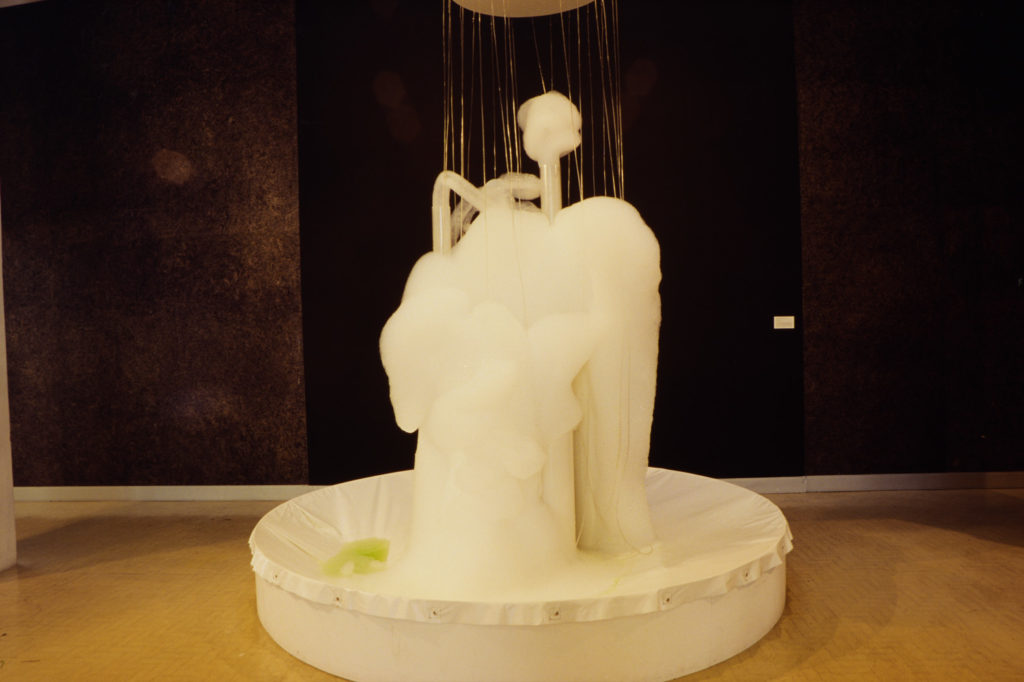ARTISTS Helen Altman, James Angus, Jim Campbell, Michaelie Crawford, Bill Culbert, Greg Evans, Lars Fredrikson, Gloria Friedmann, Juan Geuer, Mineko Grimmer, Werner Klotz, Len Lye, Paul McCarthy, Christian Marclay, Eric Orr, Nam June Paik, Garnett Puett, Art Purhonen, Charles Ray, Peter Roche, Nike Savvas, Peter Sedgley, Simon Shepheard, Jesus Rafael Soto, The Art Guys, Jennifer Turpin, Gregorio Vardanega, Darrell Viner CURATORS Andrew Bogle, Alexa Johnston OTHER VENUES Auckland Art Gallery, 26 April–28 July 1996; Dunedin Public Art Gallery SPONSORS Creative New Zealand, Australia New Zealand Foundation, IDA, Canada Department of Foreign Affairs and International Trade, Goethe Institut, Association Francaise d’Action Artistique, Australia Council for the Arts
A billboard appears on Cuba Street. Real meat bones spell out ‘Transformers’. The meat will supposedly deteriorate over time, transforming, ultimately leaving clean bones.
Transformers is about change, adaptation, mutation. Using light, sound, and heat, ice, water, and fire, and even live bees, the works transform themselves.
American artist Jim Campbell's Hallucination (1988–90) is an interactive video installation, mixing live images with video-recorded ones. This real-time ‘mirror’ shows viewers engulfed in flames, visually and audibly, following them as they move around the space.
Bill Culbert’s Light Vessels (1996) are two tall translucent boxes each containing a 1000-watt light bulb. Light appears to gradually empty out from one vessel and fill the other. The process can vary in speed, from a minute to two hours.
French artist Gloria Friedmann’s Pariah (1996) finds ham and cheese layered within sheets of glass. They are left to digest themselves, gradually decomposing over the exhibition period.
In Japanese artist Mineko Grimmer’s work, Untitled (1994), two inverted pyramids of ice melt, slowly releasing thousands of quartz pebbles. They fall over wooden boxes containing bamboo rods, taut wires, and chimes—plus water from the melted ice—creating sounds.
American sculptor Garnett Puett collaborates with 30,000 bees on Nature’s War (1996). The bees are introduced into an enclosure seven weeks prior to the show, their diets supplemented by a sugary syrup. The bees encase a sculpture of old rods and a cast icon sink in wax. The bees are free to come and go through a tube that connects their enclosure to the outside world.
Australian artist Nike Savvas strings thousands of coloured polystyrene spheres on nylon fishing lines at different heights across a gallery. They shimmer, agitated by industrial fans. Conceived as ‘a parody of Seurat’, Simple Division (1996) liberates pointillism from the fixity of the canvas.
Paul McCarthy’s Pinocchio Pipenose Household Dilemma (1994) is a participatory installation. Viewers transform themselves, donning oversized shoes, a jumpsuit, and mask to watch a video of an identically dressed overgrown Pinocchio getting up to no good with jars of viscous fluids. Tessa Laird writes ‘though technologically simple, McCarthy’s work embodies more complex themes of abuse, desire, consumerism, isolation, and human interaction than all of the Transformers works put together’.
The show is designed to be a crowdpleaser. In the Herald, T.J. McNamara describes it as a mixed bag—‘part nature corner, part junior science fair, part interactive museum, part kinetic sculpture show’. In Sunday Star Times, Mark Amery writes, ‘One essential problem with this exhibition is that it throws the work under the umbrella of “entertainment” and doesn’t encourage visitors to actually consider the works’ meaning.’ In Air New Zealand's inflight magazine, Keith Stewart says, ‘It’s amazing, it’s fantastic, it’s mind twisting, it’s fun. It may or may not be art, but, in the end, who cares?’
Ultimately, the Gallery is issued a health notice for its billboard. The bones are sprayed with resin to keep off the bacteria and flies. The process ‘has transformed exposed pieces of meat into a static piece of artwork’, observes Council spokesman Richard MacLean. ‘The whole point is now lost.’ Eventually, the bones are replaced with 300 colourful windmills.















































